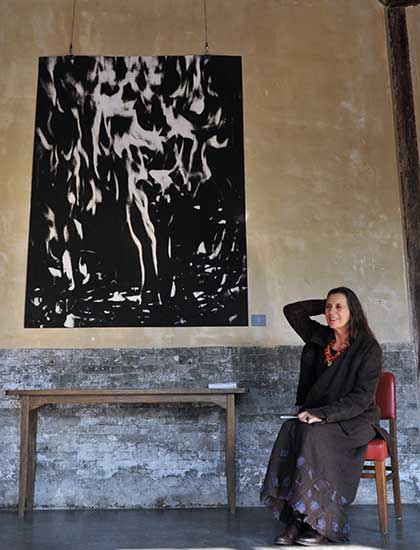Italian artist's works show influence by Chinese monk
 0 Comment(s)
0 Comment(s) Print
Print E-mail China Daily, March 4, 2016
E-mail China Daily, March 4, 2016
 |
|
Italian artist Beatrice Caracciolo is displaying her works in Beijing inspired by Chinese ink painting.[Photo by Wei Xiaohao/China Daily] |
Italian artist Beatrice Caracciolo's abstract works have long been inspired by Chinese paintings. Her debut exhibition in Beijing that opened on Tuesday seeks to show that influence.
The 61-year-old works with different media.
On show at Beijing's Temple gallery are seven large-size photo etchings from her Fire series.
Caracciolo appeared in a traditional Chinese dress at the opening of the Beijing show.
She says fire symbolizes creativity and energy-which, from her point of view, is an essential element of Chinese culture.
But her images of fire aren't in blazing red-they are black and white, the two major colors used in traditional Chinese ink painting.
"I deeply respect Chinese old art, especially the monk Shi Tao," Caracciolo says.
Shi Tao (1642-1708) was famous for his landscape paintings and calligraphy. The monk advocated the line that "what one painted came from what one saw in the mind". The idea echoed with Caracciolo, she says.
When she started etching classes at New York University decades ago, her Indian teacher introduced her to Shi Tao through a book. It has guided her creativity since.
Though the artist produces paintings, drawings, sculptures, etchings, installations and videos, her major works center on paintings that she began at the age of 8.
Many of Caracciolo's paintings are abstract.
"The amazing thing about Chinese painting is the beauty of lines or brushstrokes," she says.
A single line in Chinese ink painting can resemble a stone, a pond, a tree or anything its painter envisions, Caracciolo says. She has always wanted to understand and experiment with it.
Caracciolo visited the ancient gardens of Suzhou in East China's Jiangsu province during Spring Festival this year and experienced the charm of Chinese landscape painting.
"It was like walking into a Chinese scroll painting. I can now easily understand landscape paintings I see in Chinese museums," she says.
Caracciolo came to China with her husband, Eric de Rothschild, for the first time in 1988.
They visited the grottos of Dunhuang, a world heritage site in northwestern Gansu province. The couple has also set up a winery in Penglai in Shandong province.
"I will take some calligraphy classes in China," she says, adding she would want to apply the philosophy to her future works.
Caracciolo often plays Italian opera and other music while working.
Everything she touches becomes art, says Rothschild.
"She couldn't live without art. And the great thing is that her art evolves," he says.
Rothschild says that, when they met for the first time, she picked up a stick and made it into a piece of art. That made him feel she was the one.
As a couple with lots of art collections, Rothschild says he often gets suggestions from his wife on what pieces to buy.
Now that they come to China frequently, Caracciolo says she is considering buying works by young Chinese artists.
She has been working in France to support talented but less-recognized artists from China.
Caracciolo says she hopes there will be more chances for her to present her works in China.
If you go
11 am-9 pm, through March 31. The Temple gallery, 23 Shatan North Street, Dongcheng district, Beijing. 010-8402-1350.






Go to Forum >>0 Comment(s)